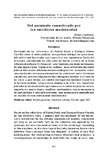Mostrar el registro sencillo del ítem
Del asesinato considerado por los escritores modernistas
| dc.rights.license | http://creativecommons.org/licenses/by-nc-sa/3.0/ve/ | |
| dc.contributor.author | Contreras, Álvaro | |
| dc.date.accessioned | 2017-03-23T18:51:25Z | |
| dc.date.available | 2017-03-23T18:51:25Z | |
| dc.date.issued | 2016-01 | |
| dc.identifier.issn | 1315-8392 | |
| dc.identifier.uri | http://www.saber.ula.ve/handle/123456789/43247 | |
| dc.description.abstract | Partiendo de las reflexiones de Rubén Darío y Enrique Gómez Carrillo sobre el relato policial, me gustaría indagar las posiciones del intelectual finisecular con respecto a esa experiencia límite del asesinato, considerado no sólo como un hecho estético (en la línea reflexiva abierta por De Quincey), sino también concebido en términos de una lógica social. Según estos autores, en la estructura del relato policial finisecular latinoamericano confluyen tres elementos clave: una noción de caso que problematiza las relaciones entre literatura y medicina, una reconfiguración del saber para afrontar el estudio de los casos y, por último, un cambio del lugar del narrador respecto a la historia contada. La presencia dinámica de estos ejes narrativos perturba la noción de delito que reposa en el centro del policial clásico, inquieta ese marco lógico, analítico, matemático, con la emergencia de una historia y un relato personal, una enunciación marcada por las huellas de una enfermedad irreconocible. | es_VE |
| dc.language.iso | es | es_VE |
| dc.rights | info:eu-repo/semantics/openAccess | |
| dc.subject | Relato policial | es_VE |
| dc.subject | América Latina | es_VE |
| dc.subject | Fin de siglo XIX | es_VE |
| dc.title | Del asesinato considerado por los escritores modernistas | es_VE |
| dc.title.alternative | Assassination as viewed by Modernist writers | es_VE |
| dc.type | info:eu-repo/semantics/article | |
| dc.description.abstract1 | Based on the reflections of Rubén Darío and Enrique Gómez Carrillo on the detective story, I inquire into the positions of the fin-desiècle intellectual on the extreme experience of murder, considered not only as an aesthetic fact (in the reflective line opened by De Quincey), but also conceived in terms of a the social logic. According to these authors, in the structure of the Latin American fin-de-siècle detective story converge three key elements: a notion of case that problematizes the relationship between literature and medicine, a reconfiguration of knowledge to deal with the study of cases and, finally, a change of the place of the narrator with respect to the story. The dynamic presence of these narrative axis disturbs the notion of crime which rests in the center of the classic police, unsettles that logical, analytical and mathematical framework, with the emergence of a history and a personal account, and a enunciation marked by traces of a unrecognizable disease. | es_VE |
| dc.description.colacion | 101-120 | es_VE |
| dc.description.email | alconber@gmail.com | es_VE |
| dc.description.frecuencia | Anual | |
| dc.identifier.depositolegal | Electrónico: PPI2012ME4041 | |
| dc.identifier.depositolegal | PP89-0023 | |
| dc.publisher.pais | Venezuela | es_VE |
| dc.subject.dependencia | Maestría en Literatura Iberoamericana | es_VE |
| dc.subject.facultad | Facultad de Humanidades y Educación | es_VE |
| dc.subject.keywords | Detective story | es_VE |
| dc.subject.keywords | Latin America | es_VE |
| dc.subject.keywords | End of the nineteenth century | es_VE |
| dc.subject.publicacionelectronica | Voz y Escritura. Revista de Estudios Literarios | |
| dc.subject.seccion | Voz y Escritura. Revista de Estudios Literarios: Artículos | es_VE |
| dc.subject.thematiccategory | Artes y Humanidades | es_VE |
| dc.subject.tipo | Revistas | es_VE |
| dc.type.media | Texto | es_VE |
Ficheros en el ítem
Este ítem aparece en la(s) siguiente(s) colección(ones)
-
Voz y Escritura. Revista de Estudios Literarios - Nº 24
enero-diciembre 2016


